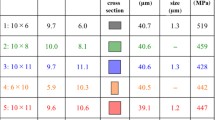Abstract
In an operation mode of atomic force microscopy that uses a higher eigenmode to determine the physical properties of material surface, the ratio between the eigenfrequency of a higher flexural eigenmode and that of the first flexural eigenmode was identified as an important parameter that affects the sensitivity and accessibility. Structure features such as cut-out are often used to tune the ratio of eigenfrequencies and to enhance the performance. However, there lacks a systematic and automatic method for tailoring the ratio. In order to deal with this issue, a shape and topology optimization problem is formulated, where the ratio between two eigenfrequencies is defined as a constraint and the area of the cantilever is maximized. The optimization problem is solved via the level set based method.
Similar content being viewed by others
References
Stark R W, Drobek T, Heckl W M. Tapping-mode atomic force microscopy and phase imaging in higher eigenmodes. Applied Physics Letters, 1999, 74(22): 3296
Hillenbrand R, Stark M, Guckenberger R. Higher-harmonic generation in tapping-mode atomic-force microscopy: Insights into the tip-sample interaction. Applied Physics Letters, 2000, 76(23): 3478
Sahin O, Quate C F, Solgaard O, Atalar A. Resonant harmonic response in tapping-mode atomic force microscopy. Physical Review B: Condensed Matter and Materials Physics, 2004, 69(16): 165416
Sahin O, Yaralioglu G, Grow R, Zappe S F, Atalar A, Quate C, Solgaard O. High-resolution imaging of elastic properties using harmonic cantilevers. Sensors and Actuators A: Physical, 2004, 114(2–3): 183–190
Li H, Chen Y, Dai L. Concentrated-mass cantilever enhances multiple harmonics in tapping-mode atomic force microscopy. Applied Physics Letters, 2008, 92(15): 151903
Sethian J A, Wiegmann A. Structural boundary design via level set and immersed interface methods. Journal of Computational Physics, 2000, 163(2): 489–528
Osher S, Santosa F. Level-set methods for optimization problems involving geometry and constraints: Frequencies of a two-density inhomogeneous drum. Journal of Computational Physics, 2001, 171(1): 272–288
Allaire G, Jouve F, Toader A M. A level-set method for shape optimization. Comptes Rendus Mathematique, 2002, 334(12): 1125–1130
Allaire G, Jouve F, Toader A M. Structural optimization using sensitivity analysis and a level-set method. Journal of Computational Physics, 2004, 194(1): 363–393
Wang M Y, Wang X M, Guo D M. A level set method for structural topology optimization. Computer Methods in Applied Mechanics and Engineering, 2003, 192(1–2): 227–246
Pedersen N L. Maximization of eigenvalue using topology optimization. Structural and Multidisciplinary Optimization, 2000, 20(1): 2–11
Pedersen N L. Design of cantilever probes for atomic force microscopy (AFM). Engineering Optimization, 2000, 32(3): 373–392
Chen K N. Model updating and optimum designs for V-shaped atomic force microscope probes. Engineering Optimization, 2006, 38(7): 755–770
Díaaz A, Kikuchi N. Solution to shape and topology eigenvalue optimization problems using a homogenization method. International Journal for Numerical Methods in Engineering, 1992, 35(7): 1487–1502
Ma Z D, Cheng H C, Kikuchi N. Structural design for obtaining desired eigenfrequencies 23 by using the topology and shape optimizationg method. Computing Systems in Engineering, 1994, 5(1): 77–89
Kosaka I, Swan C C. A symmetry reduction method for continuum structural topology optimization. Computers & Structures, 1999, 70(1): 47–61
Allaire G, Jouve F. A level-set method for vibration and multiple loads structural optimization. Computer Methods in Applied Mechanics and Engineering, 2005, 194(30-33): 3269–3290
Du J B, Olhoff N. Topological design of freely vibrating continuum structures for maximum values of simple and multiple eigenfrequencies and frequency gaps. Structural and Multidisciplinary Optimization, 2007, 34(2): 91–110
Xia Q, Shi T, Wang M Y. A level set based shape and topology optimization method for maximizing the simple or repeated first eigenvalue of structure vibration. Structural and Multidisciplinary Optimization, 2011, 43(4): 473–485
Hopcroft MA, Nix WD, Kenny TW. What is the Young’s modulus of silicon? Journal of Microelectromechanical Systems, 2010, 19(2): 229–238
Zienkiewicz O C, Taylor R L. The Finite Element Method (5th Edition), Vol. 2. Butterworth-Heinemann, 2000
Liew K M, Wang C M, Xiang Y, Kitipornchai S. Vibration of Mindlin Plates: Programming the P-Version Ritz Method. Elsevier, 1998
Xing Y, Liu B. Closed form solutions for free vibrations of rectangular Mendelian plates. Acta Mechanica Sinica, 2009, 25(5): 689–698
Choi K K, Kim N H. Structural Sensitivity Analysis and Optimization. Springer, 2005
Haug E J, Choi K K, Komkov V. Design Sensitivity Analysis of Structural Systems. Academic Press, 1986
Nocedal J, Wright S J. Numerical Optimization. Springer, 1999
Wang X M, Wang M Y, Guo D M. Structural shape and topology optimization in a level-set-based framework of region representation. Structural and Multidisciplinary Optimization, 2004, 27(1–2): 1–19
Mei Y, Wang X. A level set method for structural topology optimization and its applications. Advances in Engineering Software, 2004, 35(7): 415–441
Xia Q, Shi T L, Wang M Y, Liu S Y. A level set based method for the optimization of cast part. Structural and Multidisciplinary Optimization, 2010, 41(5): 735–747
Xia Q, Shi T, Liu S, Wang M Y. A level set solution to the stressbased structural shape and topology optimization. Computers & Structures, 2012, 90–91: 55–64
Sethian J A. Level Set Methods and Fast Marching Methods: Evolving Interfaces in Computational Geometry, Fluid Mechanics, Computer Vision, and Materials Science. 2nd Edition. Cambridge Monographs on Applied and Computational Mathematics. Cambridge, UK: Cambridge University Press, 1999
Osher S, Fedkiw R. Level Set Methods and Dynamic Implicit Surfaces. New York: Springer-Verlag, 2002
Tcherniak D. Topology optimization of resonating structures using SIMP method. International Journal for Numerical Methods in Engineering, 2002
Author information
Authors and Affiliations
Corresponding author
Rights and permissions
About this article
Cite this article
Xia, Q., Zhou, T., Wang, M.Y. et al. Shape and topology optimization for tailoring the ratio between two flexural eigenfrequencies of atomic force microscopy cantilever probe. Front. Mech. Eng. 9, 50–57 (2014). https://doi.org/10.1007/s11465-014-0286-x
Received:
Accepted:
Published:
Issue Date:
DOI: https://doi.org/10.1007/s11465-014-0286-x




